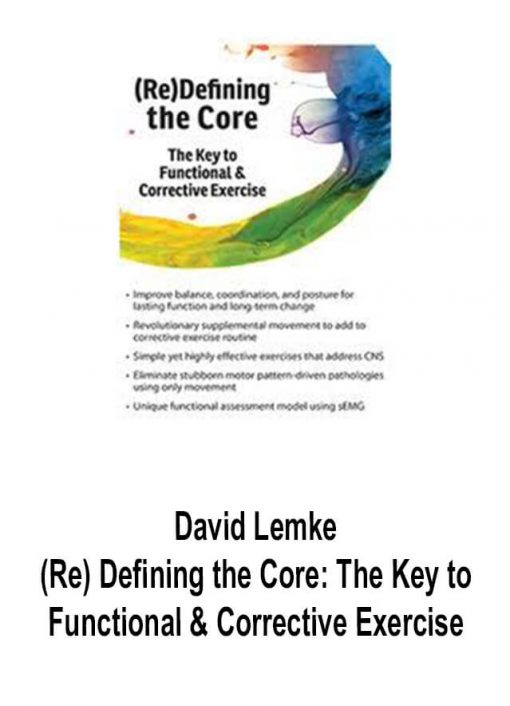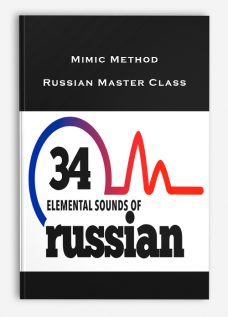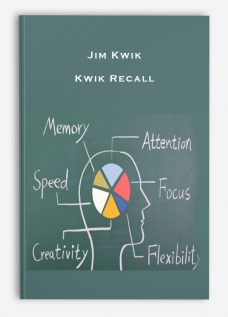David Lemke – (Re) Defining the Core: The Key to Functional & Corrective Exercise
Original price was: $199.00.$57.00Current price is: $57.00.
- Description
Description
Download Immediately!
Watch Proof Content Below:

David Lemke – (Re) Defining the Core: The Key to Functional & Corrective Exercise
Clinicians understand that lasting pain relief and truly improved fitness depend on core stability and peripheral mobility. But long-term results are elusive! It is generally agreed that to have peripheral mobility, you must have core stability. Functional exercise is any exercise which acknowledges this and engages the body for this express purpose.
Observe how EMG explores the primary defensive bias governing the Central Nervous System, the body’s true Core. Once we have observed this bias, which we’ll call the “Twist,” we discuss how it leads to the most common functional problems. Rather than focusing on targeting areas for strength or stability, participants learn to correct movement dysfunction by directing appropriate exercise toward the CNS. These methods can be easily learned and applied by athletic trainers and related health and fitness professionals, massage therapists, physical and occupational therapists – anyone who uses exercise as part or all of their program. You will complete this recording equipped with new knowledge and strategies to help move clients and patients through the vital steps toward lasting function: improved balance, coordination, and effortless posture.
- Describe how measurable (visible) pathologies correspond with underlying muscle patterns.
- Explain the concept of learned motor patterns driving tissue adaptation (Wolff’s Law).
- Apply exercises which target the CNS to restore muscle inventory lost to compensation.
- Identify and correct defensive postural adaptation using a single integrated motion.
- Demonstrate movement strategies which are immediately and favorably integrated by the CNS, thus avoiding exercises which the body resists as “invasion.”
VITAL DEFINITIONS: ESSENTIAL ELEMENTS OF CORE COMMUNICATION
- Correctly defining the CORE is key to functional training
- Rules of communication
- How the technology explosion in healthcare impairs genuine communication
- Why outcomes have not improved in an age of research data availability
- The Definition Game: 10 ill-defined words we all rely on every day
LAB: KINESIOLOGICAL SURFACE EMG TESTING
- Volunteers selected, skin preparation, system test
- Single arm raise task in standing
- Video and sEMG recording of test activity
- We take requests: “Any movement you’re curious about? Let’s test it!”
MUSCLES 101
- Learning how the CNS sees muscles
- Reviewing sEMG data to observe “chains” vs. groups
- Muscles, mood, and movement (Cuddy, et. al. i.e. current research review)
- CNS perspective: Opposing chains with broken links
- Implications of CNS as CORE: Motor learning in an always on, 24/7, learning, adapting system
WHAT IS THE CORE TWIST: HOW THE HUMAN MOTOR SYSTEM TRAINS ITSELF
- Lower quarter symptoms – most common underlying pathologies – the Core pattern as driver
- Upper quarter symptoms – most common pathologies – the Core pattern as driver
- Review of definitions from the Definition Game
- How far off were we?
- Recognizing the simple elegance of functional chains
TRAINING FUNCTIONAL CHAINS: EXERCISING OUT OF THE TWIST
- Training vs. exercise: Targeting the CNS with structured, resisted movement
- Opposing teams or an orchestra at work?
- Crosstraining out of the Twist
- Any exercise NOT countering the Twist is NOT Functional
LAB: THE FUNCTIONAL CHAIN GAME
- Workshop it !
- Demo and practice: XC Skiing, backwards resisted walking, etc.
- Best of the group brainstorming: FCT demo and SkiX activity
- Signs of success: Posture, balance, and youthful boldness
















